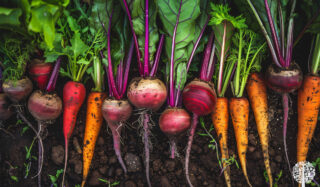Long-Term Storage Solutions For Your Vegetable Harvest
How To Store Your Vegetable Harvest For The Cold Months Ahead
You’ve been lovingly tending to your garden for several months, and now it’s time to reap the rewards. Harvest season is the most wonderful time of year for many gardeners. It is essential to know how to store fruits and vegetables to preserve and enjoy them throughout the colder months ahead. Below is a list of common fall crops and the best ways to prepare your root cellar, courtesy of The Old Farmer’s Almanac: Vegetable Gardener’s Handbook.


How To Store Corn
There’s nothing sweeter than corn harvested straight from the garden. Unfortunately, this crop doesn’t keep too long. For maximum flavor and nutrition, eat corn within a few days of harvest. If you want to store corn long-term, blanch the cobs, remove the kernels, and freeze. You can also use a pressure canner for preservation. [
How To Store Carrots
Don’t harvest these babies too early! A frost will encourage carrots to produce sugars, resulting in a sweeter taste. You can store fresh carrots by removing all but a ½ inch of the tops. Clean the carrots well and air-dry them before sealing them in a plastic bag in the fridge. Keep carrots longer by storing in tubs of moist sand or dry sawdust in a cool, dry area.
How To Store Beets
Fresh beets will keep well in the fridge for about a week, but they’ll be good longer if you remove the greens and store them separately. To enjoy beets throughout winter, brush the soil from the roots and bury them (not touching) in dry sand, peat moss, or sawdust. Keep the bin in a cool, dry place.
How To Store Brussels Sprouts
Brussels sprouts are another crop that can handle a frost. After it gets cold, remove all the leaves, pull up the stalk, including the roots, and hang it upside down in a cool, dry basement or garage. Without the roots, you can store stalks in a root cellar or basement for about a month. Only wash them immediately before eating. If you’re harvesting Brussels sprouts fresh from the garden, they’ll keep in the fridge for about five days.
How To Store Kale
Kale is one of those magical greens that will grow even in the coldest of temperatures. It won’t stop until it drops to about 20°F (-6.6°C). Harvest continually, but don’t harvest too much at once because this leaf is good in the fridge for only about a week.
How To Store Onions
Storing a bumper harvest of onions is a bright idea if it’s a go-to in your kitchen. Pull the onions from the garden when the tops are brown; cut the roots and trim the tops back to an inch or two. Rest the onions on dry ground for a few days to allow them to cure, and once they’re dry, hang them in a mesh bag or store them in a box in a dry, well-ventilated area. The farmer’s almanac recommends storing onions away from pears or apples because an ethylene gas produced by the fruit will interrupt the onion’s dormancy. Sweet onions don’t keep well.
How To Store Parsnips
Harvest parsnips after a couple of frosts so they turn nice and sweet. Trim their leaves to about two or three inches, and store parsnips at 32°F to 35°F with 95% humidity. You can store parsnips for up to six months if you keep them in damp sand, sawdust, or leaves.


How To Store Potatoes
If you like eating the most delicious potatoes from the garden all winter, you’re lucky because they store very well. Put freshly dug potatoes in a dry, cool place for about two weeks to let the skin cure. After that, brush off the remaining soil and store in a cool (and somewhat humid), dark place. Like onions, don’t keep potatoes near apples!
How To Store Pumpkins
Harvest pumpkins in time to decorate your porch for Halloween, then cure them for a week in a sunny spot that is 80°F to 85°F, with 80-85% humidity. This will toughen the pumpkin’s skin and boost its flavor for cooking. After ten days, you can store the pumpkins in a cool, dry cellar at about 50°F for up to three months.
How To Store Rutabaga
You can enjoy rutabagas in soups and stews or roasted all winter with proper storage techniques. Cut off the foliage and store rutabaga just above the freezing mark in a space with 90-95% humidity. They will keep well for about four months.
How To Store Winter Squash
Harvest winter squash when the skin is tough, and the leaves have turned brown. The Farmer’s Almanac recommends washing in a low-concentration bleach rinse (½ cup bleach to 5 cups water) to remove all bacteria. Air-dry the fruit, then store it in a cool (40°F) dark space with good ventilation. Most varieties will keep the entire winter, except acorn squash, which typically lasts a few weeks.




